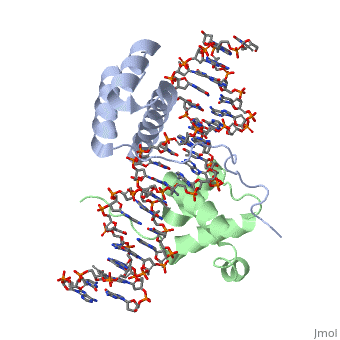Tyrone Evans Hox Proteins sandbox
From Proteopedia
(Difference between revisions)
| Line 10: | Line 10: | ||
As mentioned previously, homeotic transformations can alter DNA sequences so that specific proteins will have different functions, and certain genes will be either activated or deactivated. More specifically, if a certain hox protein is responsible for the development of legs on a fly in the middle region of its body, a homeotic transformation can cause this protein to carry out this same function in a different area. In this example, this altered protein can activate the gene for leg development to change the antennae to legs on that fly's head, as seen in multiple experiments. And biologists believe this to be true for Hox genes in flies, mice, humans, and other animals. | As mentioned previously, homeotic transformations can alter DNA sequences so that specific proteins will have different functions, and certain genes will be either activated or deactivated. More specifically, if a certain hox protein is responsible for the development of legs on a fly in the middle region of its body, a homeotic transformation can cause this protein to carry out this same function in a different area. In this example, this altered protein can activate the gene for leg development to change the antennae to legs on that fly's head, as seen in multiple experiments. And biologists believe this to be true for Hox genes in flies, mice, humans, and other animals. | ||
| - | == Hox Protein | + | == Hox Protein Regulation == |
Hox genes, which hold the instructions for how each protein should be constructed, are regulated by both gap genes and pair-rule genes. Gap genes are responsible for the development of particular sections of an organism, more specifically for embryos of some arthropods. If a mutation occurs with these genes, adjoining body sections can be loss. Pair-rule genes are similar to gap genes but instead of being involved in the development of arthropods, it participates in the segment development of insects. And both of these regulators are ultimately regulated by maternally-supplied mRNA. In a series of events, depending on the amount of said maternally-supplied mRNA either the gap or pair-rule genes are activated, which in turn activate the Hox genes, allowing them to cause a differentiation in the genes that are responsible for the construction of proteins for embryo development. | Hox genes, which hold the instructions for how each protein should be constructed, are regulated by both gap genes and pair-rule genes. Gap genes are responsible for the development of particular sections of an organism, more specifically for embryos of some arthropods. If a mutation occurs with these genes, adjoining body sections can be loss. Pair-rule genes are similar to gap genes but instead of being involved in the development of arthropods, it participates in the segment development of insects. And both of these regulators are ultimately regulated by maternally-supplied mRNA. In a series of events, depending on the amount of said maternally-supplied mRNA either the gap or pair-rule genes are activated, which in turn activate the Hox genes, allowing them to cause a differentiation in the genes that are responsible for the construction of proteins for embryo development. | ||
| Line 17: | Line 17: | ||
== Interaction with DNA == | == Interaction with DNA == | ||
| - | A homeodomain is an essential part that all Hox proteins possess. The homeodomain can be found within the homeobox, a DNA sequence found within genes that are responsible of morphogenesis of living organisms. This sequence codes for homeodomain protein products, 60 amino-acid segments, which have specific folding patterns (helix-turn-helix) that allows them to bind with DNA through a <scene name='71/714951/Taaat_sequence/1'>5’- | + | A homeodomain is an essential part that all Hox proteins possess. The homeodomain can be found within the homeobox, a DNA sequence found within genes that are responsible of morphogenesis of living organisms. This sequence codes for homeodomain protein products, 60 amino-acid segments, which have specific folding patterns (helix-turn-helix) that allows them to bind with DNA through a <scene name='71/714951/Taaat_sequence/1'>5’-TAAAT-3’</scene> core motif. This domain consist of three helical regions folded into a tight spherical structure (need picture of structure). There are two antiparallel N-terminal helices and one C-terminal helix within this domain. The C-terminal helix binds directly with DNA through the use of hydrogen bonds and hydrophobic interactions between side chains and the outer bases and thymine methyl groups within the major groove of a DNA helix. The <scene name='71/714951/Recognition_helix/1'>Recognition helix</scene> within homeodomain binds within the <scene name='71/714951/Dna_major_groove/1'>major groove</scene> of a DNA helix, while the <scene name='71/714951/Amino-terminal_tail/1'>Amino-Terminal tail</scene> binds within the <scene name='71/714951/Dna_minor_groove/1'>minor groove</scene> of a DNA helix. |
== Human Hox Genes == | == Human Hox Genes == | ||
Revision as of 01:32, 21 October 2015
Hox Proteins
| |||||||||||

